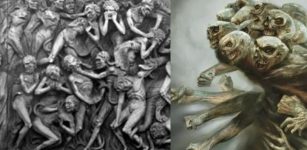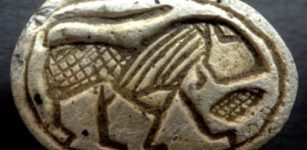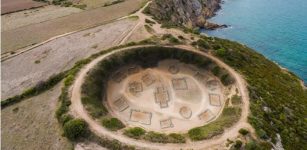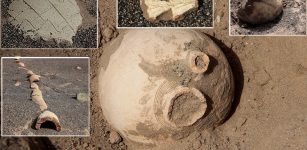Yokai Kijo (Kidjo): Demoness, Cannibal With Hideous Heart Is A Moral Reminder In Japanese Beliefs
A. Sutherland - AncientPages.com - The narratives surrounding the mythical female demons, known as 'kijo', carry a profound moral lesson: women who engage in unethical or immoral conduct risk transforming into malevolent entities that feast on humans.
Image credit: Adobe Stock - cegli 222
Kijo (or Kidjo) is a demoness, a cannibal woman usually wearing rags. In the beautiful beliefs of Japanese people, she is a yokai ("Yōkai") like thousands of other yokai figures.
The younger ones are called "kijo" while the ones that look like old ladies are called onibaba ("demon hag"). Kijo is usually huge but sometimes can be small. They are ugly; their appearance may vary; some of these monsters have (red or yellow eyes, blue skin, sharp horns, long claws, and dirty, matted hair.
These entities possess the extraordinary ability to shapeshift into alternative humanoid forms. As beautiful young ladies, they can be very dangerous trying to charm men. They also exhibit an insatiable craving for human flesh, which can be classified as an addiction. These beings are endowed with various supernatural characteristics that defy conventional understanding.
What did happen to these women?
Vengeful women turn into demons. According to Japanese folk tradition, women who have been betrayed by their husbands or abused or mistreated girls and grandmothers can turn into demons or monsters.
However, the term 'kijo' predominantly refers to females who have undergone a metamorphosis from human beings into monstrous entities, either as a consequence of committing terrible crimes, succumbing to uncontrollable and perilous jealousy, or harboring intense hatred and malice.
The print depicts the herione Kiyohime in distress on the banks of the Hidaka River. Chikanobu Toyohara, The Boatman, 1898. Triptych from the Bamboo Knots (Take no Hitofushi) series. Public Domain
Such highly negative feelings and actions influenced by them undoubtedly corrupt the pure soul. These individuals, having forsaken the rules of polite society, sought refuge in isolated dwellings such as abandoned residences or secluded mountain caverns or even made use of wandering along desolate roads under the veil of darkness.
This yokai's only goal is to continue committing evil deeds. Extremely powerful and dangerous, Kijo demonesses are skilled in the secrets of magic. They are highly capable of casting spells and brewing deadly poisons and potions.
Kijos do not act in groups. Instead, they prefer to act alone and are often driven by personal motives. Japanese legends say that they act either as persecutors of sinners in the underworld or as a threat to human society in the human world.
A particular moral lesson dominates in all stories about the Kijo demoness. It says that women who do bad things can become evil creatures, and men who follow them and succumb to their charm may ruin their lives or encounter their ultimate demise.
There are countless legends of Kijo female monsters in Japanese folklore. Most of them, however, were not created to scare people but as entertainment, warnings, or moral reminders.
Generally, 'Kijo' can be defined as a designation for any demonic or supernatural entity of the feminine gender with malevolent or otherworldly characteristics that can be found within various cultural traditions.
Section of the scroll Dojoji Engi Emaki illustrating the story where the serpent burns the bell killing the monk. Image credit: Unknown author - Dojo-ji engi emaki - Date : Muromachi period (16th) - Wakayama Prefecture, Japan. Public Domain
One of the most famous legends of Kijo demons in Japanese folklore is the tale of Kiyohime. According to this ancient narrative, Kiyohime was the daughter of Shaji, the respected leader of a village. Their family was popular and respected for extending hospitality to travelers passing through their community.
Kiyohime And Unreturned Love
The tale of Kiyohime and Monk Anchin explores the complexities of unreturned love.
Kiyohime, a village maiden, fell in love with a monk, Anchin, who once visited her village. The monk responded to Kiyohime's affections, but it was more on an aesthetic level, admiring her beauty.
Unfortunately, he did not want to pursue a deeper, more passionate connection with the girl. Driven by her intense emotions, Kiyohime decided to pursue the monk, which finally caused a tragic end.
Legend says that the monk escaped to the banks of the Hidaka River, begging the sailors to refrain from helping the girl cross the river. Kiyohime did not want to give up her pursuit. Consumed by her wrath, she decided to swim across the river herself. As she entered the currents, something extraordinary happened. Her fury manifested in a remarkable transformation, causing Kiyohime to assume the form of a serpent.
The monk Anchin saw this and took refuge in a temple, asking the temple to hide him in a bell. It did not help much. Kiyohime followed him and found the bell. Spitting fire through her mouth, she melted the bell and killed the monk. Kiyohime is considered a snake woman who kidnaps men in villages.
Written by – A. Sutherland - AncientPages.com Senior Staff Writer
Copyright © AncientPages.com All rights reserved. This material may not be published, broadcast, rewritten or redistributed in whole or part without thexpress written permission of AncientPages.com
More From Ancient Pages
-
 Impressive Pyramid Of Kukulkan (El Castillo’) At Chichen Itza
Civilizations | Feb 7, 2017
Impressive Pyramid Of Kukulkan (El Castillo’) At Chichen Itza
Civilizations | Feb 7, 2017 -
 Māori Connections To Antarctica May Go As Far Back As 7th Century
Archaeology | Jun 9, 2021
Māori Connections To Antarctica May Go As Far Back As 7th Century
Archaeology | Jun 9, 2021 -
 How Did Mesopotamia Change The World?
Civilizations | Jan 18, 2020
How Did Mesopotamia Change The World?
Civilizations | Jan 18, 2020 -
 Maya Storm God Huracán Taught That When We Damage Nature, We Damage Ourselves
Featured Stories | Oct 4, 2024
Maya Storm God Huracán Taught That When We Damage Nature, We Damage Ourselves
Featured Stories | Oct 4, 2024 -
 On This Day In History: ENIGMA The Secret Code Used By Germans Was Finally Broken- On July 9, 1941
News | Jul 9, 2016
On This Day In History: ENIGMA The Secret Code Used By Germans Was Finally Broken- On July 9, 1941
News | Jul 9, 2016 -
 Hidden Connection Between The Zodiac, Ancient Egypt, Freemasonry And Christianity
Ancient Mysteries | Aug 14, 2018
Hidden Connection Between The Zodiac, Ancient Egypt, Freemasonry And Christianity
Ancient Mysteries | Aug 14, 2018 -
 Utukku: Sumerian Spirit From The Underground That Obeyed The Will Of God Anu
Featured Stories | Jun 17, 2016
Utukku: Sumerian Spirit From The Underground That Obeyed The Will Of God Anu
Featured Stories | Jun 17, 2016 -
 Deir el-Bahri – Sacred Resting Place For The Pharaohs
Featured Stories | Mar 22, 2022
Deir el-Bahri – Sacred Resting Place For The Pharaohs
Featured Stories | Mar 22, 2022 -
 A Scarab Seal At Tel Gerisa, Depicts Walking Lion – Symbol Of Strength, Power And Authority
Archaeology | Sep 5, 2023
A Scarab Seal At Tel Gerisa, Depicts Walking Lion – Symbol Of Strength, Power And Authority
Archaeology | Sep 5, 2023 -
 LIDAR Discovers Circular Iron Age Village At Cap d’Erquy, France
Archaeology | Apr 4, 2024
LIDAR Discovers Circular Iron Age Village At Cap d’Erquy, France
Archaeology | Apr 4, 2024 -
 A Tooth That Rewrites History? The Discovery Challenging What We Knew About Neanderthals
DNA | Oct 23, 2023
A Tooth That Rewrites History? The Discovery Challenging What We Knew About Neanderthals
DNA | Oct 23, 2023 -
 13,000-Year-Old Engraving May Depict First Paleolithic Social Group Of Humans
Archaeology | Dec 4, 2015
13,000-Year-Old Engraving May Depict First Paleolithic Social Group Of Humans
Archaeology | Dec 4, 2015 -
 Ruins Of Ancient City Emerged From The Sand In Kerman Province, Iran
Archaeology | Apr 15, 2017
Ruins Of Ancient City Emerged From The Sand In Kerman Province, Iran
Archaeology | Apr 15, 2017 -
 Did Ancient Seafarers In Southeast Asia Build Sophisticated Boats As Far Back As 40,000 Years Ago?
Archaeology | Feb 24, 2025
Did Ancient Seafarers In Southeast Asia Build Sophisticated Boats As Far Back As 40,000 Years Ago?
Archaeology | Feb 24, 2025 -
 Has A New Study Of 5,000-Year-Old DNA Solved The Mystery Of The Tarim Basin Mummies?
Civilizations | Mar 31, 2022
Has A New Study Of 5,000-Year-Old DNA Solved The Mystery Of The Tarim Basin Mummies?
Civilizations | Mar 31, 2022 -
 Mysterious Skeletons Of A Tall Unknown Race Discovered In California – Who Were These Beings?
Featured Stories | Apr 10, 2024
Mysterious Skeletons Of A Tall Unknown Race Discovered In California – Who Were These Beings?
Featured Stories | Apr 10, 2024 -
 Underwater Ancient Cypress Forest Offers Clues To The Past
Archaeology | Jun 29, 2021
Underwater Ancient Cypress Forest Offers Clues To The Past
Archaeology | Jun 29, 2021 -
 Abu Dhabi Fossil Dunes May Have Inspired The Ancient Great Flood Story – Professor Says
Archaeology | Jul 10, 2022
Abu Dhabi Fossil Dunes May Have Inspired The Ancient Great Flood Story – Professor Says
Archaeology | Jul 10, 2022 -
 Ancient Societies Ruled By Ruthless Dictators – Collapsed
Civilizations | Oct 18, 2020
Ancient Societies Ruled By Ruthless Dictators – Collapsed
Civilizations | Oct 18, 2020 -
 Unexplained Mystery In Ohio – Unusual Force Puzzles Scientists
Featured Stories | Dec 21, 2018
Unexplained Mystery In Ohio – Unusual Force Puzzles Scientists
Featured Stories | Dec 21, 2018



